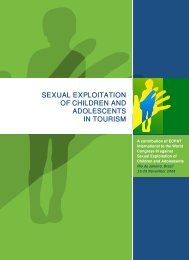to download the document in PDF format - Child Centre: Expert ...
to download the document in PDF format - Child Centre: Expert ...
to download the document in PDF format - Child Centre: Expert ...
Create successful ePaper yourself
Turn your PDF publications into a flip-book with our unique Google optimized e-Paper software.
1.2.1 Transnational and mult<strong>in</strong>ational corporationsAccord<strong>in</strong>g <strong>to</strong> <strong>the</strong> UN, <strong>the</strong> term transnational corporation (TNC) refers <strong>to</strong> an economicentity operat<strong>in</strong>g <strong>in</strong> more than one country or a cluster of economic entities operat<strong>in</strong>g <strong>in</strong> twoor more countries – whatever <strong>the</strong>ir legal form, whe<strong>the</strong>r <strong>in</strong> <strong>the</strong>ir home country or country ofactivity, and whe<strong>the</strong>r taken <strong>in</strong>dividually or collectively. 15 The UN’s <strong>document</strong>s do not havea published def<strong>in</strong>ition of <strong>the</strong> term “mult<strong>in</strong>ational”. However, <strong>the</strong> International LabourOrganisation (ILO), a UN specialised agency that seeks <strong>to</strong> promote human and labourrights, has def<strong>in</strong>ed mult<strong>in</strong>ational corporations (MNC) as “enterprises, whe<strong>the</strong>r <strong>the</strong>y are ofpublic, mixed or private ownership, which own or control production, distribution, servicesor o<strong>the</strong>r facilities outside <strong>the</strong> country <strong>in</strong> which <strong>the</strong>y are based. The degree of au<strong>to</strong>nomy ofentities with<strong>in</strong> mult<strong>in</strong>ational enterprises <strong>in</strong> relation <strong>to</strong> each o<strong>the</strong>r varies widely from onesuch enterprise <strong>to</strong> ano<strong>the</strong>r, depend<strong>in</strong>g on <strong>the</strong> nature of <strong>the</strong> l<strong>in</strong>ks between such entities and<strong>the</strong>ir fields of activity and hav<strong>in</strong>g regard <strong>to</strong> <strong>the</strong> great diversity <strong>in</strong> <strong>the</strong> form of ownership,size, <strong>in</strong> <strong>the</strong> nature and location of <strong>the</strong> operations of <strong>the</strong> enterprises concerned.” 16In contrast, <strong>the</strong> Organisation for Economic Cooperation and Development 17 (OECD)has stated, “[MNCs] usually comprise companies or o<strong>the</strong>r entities established <strong>in</strong> morethan one country and so l<strong>in</strong>ked that <strong>the</strong>y may coord<strong>in</strong>ate <strong>the</strong>ir operations <strong>in</strong> various ways.While one or more of <strong>the</strong>se entities may be able <strong>to</strong> exercise a significant <strong>in</strong>fluence over <strong>the</strong>activities of o<strong>the</strong>rs, <strong>the</strong>ir degree of au<strong>to</strong>nomy with<strong>in</strong> <strong>the</strong> enterprise may vary widely fromone mult<strong>in</strong>ational enterprise <strong>to</strong> ano<strong>the</strong>r. Ownership may be private, state or mixed.” 18Although often used <strong>in</strong>terchangeably, <strong>the</strong> dist<strong>in</strong>ction between a transnational and amult<strong>in</strong>ational corporation is an important one. As Korten expla<strong>in</strong>s <strong>in</strong> his book, WhenCorporations Rule <strong>the</strong> World:Dur<strong>in</strong>g <strong>the</strong> transition phase from national <strong>to</strong> transnational, many corporationsstyled <strong>the</strong>mselves as ‘mult<strong>in</strong>ational,’ which meant that <strong>the</strong>y <strong>to</strong>ok on many nationalidentities, ma<strong>in</strong>ta<strong>in</strong><strong>in</strong>g relatively au<strong>to</strong>nomous production and sales facilities <strong>in</strong><strong>in</strong>dividual countries, establish<strong>in</strong>g local roots and present<strong>in</strong>g <strong>the</strong>mselves <strong>in</strong> eachlocality as a good local citizen. Globalized operations might be l<strong>in</strong>ked <strong>to</strong> oneano<strong>the</strong>r, but <strong>the</strong>y were deeply <strong>in</strong>tegrated <strong>in</strong><strong>to</strong> <strong>the</strong> <strong>in</strong>dividual local economies <strong>in</strong>which <strong>the</strong>y operated. Dur<strong>in</strong>g this phase, many did function <strong>to</strong> some extent aslocal citizens.As structural adjustment programs and free trade agreements rendered nationaleconomic borders <strong>in</strong>creas<strong>in</strong>gly irrelevant, most corporations that operatePrivate Sec<strong>to</strong>r Accountability <strong>in</strong> Combat<strong>in</strong>g <strong>the</strong> Commercial Sexual Exploitation of <strong>Child</strong>ren|9




